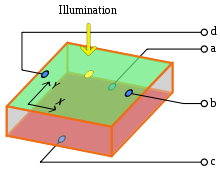- Position sensitive device
-
A Position Sensitive Device and/or Position Sensitive Detector (PSD) is an optical position sensor (OPS), that can measure a position of a light spot in one or two-dimensions on a sensor surface.
Contents
Principles
PSDs can be divided into two classes which work according to different principles: In the first class, the sensors have an isotropic sensor surface that has a raster-like structure that supplies continuous position data. The second class has discrete sensors on the sensor surface that supply local discrete data.
Isotropic Sensors
The technical term PSD was first used in a 1957 publication by J.T. Wallmark for lateral photoelectric effect used for local measurements. On a laminar semiconductor, a so-called PIN diode is exposed to a tiny spot of light. This exposure causes a change in local resistance and thus electron flow in four electrodes. From the currents Ia, Ib, Ic and Id in the electrodes, the location of the light spot is computed using the following equations.
and
The kx and ky are simple scaling factors, which permit transformation into coordinates.
An advantage of this process is the continuous measurement of the light spot position with measuring rates up to over 100 kHz. The dependence of local measurement on form and size of the light spot as well as the nonlinear connection are a disadvantage that can be partly compensated by special electrode shapes.
Discrete Sensors
Serial Processing
The most common sensor applications with a sampling rate of less than 1000 Hz are CCD or CMOS cameras. The sensor is partitioned into individual pixels whose exposure value can be read out sequentially. The position of the light spot can be computed with the methods of photogrammetry directly from the brightness distribution.
Parallel Processing
For faster applications, matrix sensors with parallel processing were developed. Both line by line and in columns, the density of light of each pixel is compared with a global threshold value. The results of comparison become lines and columns with logical OR links. From all columns and all lines the one element that is brighter than a given threshold value is the average value of the coordinates computed of the light spot.
References
- Anssi Mäkynen: Position-Sensitive Devices and Sensor Systems for optical Tracking and Displacement Sensing Application. Dissertation, Faculty of Technology, University of Oulu, 2000, Abstract and PDF, ISBN 951-42-5780-4
- Henrik Andersson, Position Sensitive Detectors : Device Technology and Applications in Spectroscopy. Dissertation, Department of Information Technology and Media, Mid Sweden University, Sundsvall, Sweden, 2008, PDF, ISBN 978-91-85317-91-2
- Nicola Massari, Lorenzo Gonzo, Massimo Gottardi and Andrea Simoni: High Speed Digital CMOS 2D Optical Position Sensitive Detector. ESSCIRC, Firenze, Italy, Sept. 2002, PDF
- J. T. Wallmark: A new semiconductor photocell using lateral photoeffect. Proceedings of the IRE, Vol. 45, S. 474-483, 1957
External links
See also
Categories:- Semiconductor devices
- Optoelectronics
- Sensors
- Optical diodes
Wikimedia Foundation. 2010.




